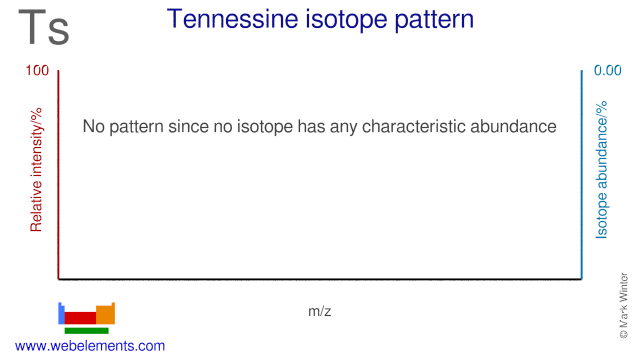Tennessine - 117Ts: the essentials
- Name: tennessine
- Symbol: Ts
- Atomic number: 117
- Relative atomic mass (Ar): [ 293 ] (longest lived isotope)
- Standard state: presumably a solid at 298 K
- Appearance: unknown, but probably metallic and dark in appearance
- Classification: Unknown
- Group in periodic table: 17
- Group name: Halogen
- Period in periodic table: 7
- Block in periodic table: p
- Shell structure: 2.8.18.32.32.18.7
- CAS Registry: 87658-56-8
Tennessine atoms have 117 electrons and the shell structure is 2.8.18.32.32.18.7. The ground state electronic configuration of neutral tennessine is [Rn].5f14.6d10.7s2.7p5 (a guess based upon that of astatine) and the term symbol of tennessine is 2P3/2 (a guess based upon guessed electronic structure).
Tennessine: description
On 8 June 2016 IUPAC announced the new name tennessine (symbol Ts) for element 117 in place of the temporary systematic name ununseptium (Uus). A five-month review period expires 8 November 2016 to review this name prior to formal approval by IUPAC.
An article published in Physical Review Letters on 5 April 2010 (submitted 15 March 2010, "Synthesis of a new chemical element with atomic number Z=117", Joint Institute for Nuclear Research, RU-141980 Dubna, Russian Federation, Oak Ridge National Laboratory, Oak Ridge, Tennessee 37831, USA, University of Nevada Las Vegas, Las Vegas, Nevada 89154, USA, Department of Physics and Astronomy, Vanderbilt University, Nashville, Tennessee 37235, USA, Lawrence Livemore National Laboratory, Livermore, California 94551, USA, and Research Institute of Atomic Reactors, RU-433510 Dimitrovgrad, Russian Federation) claims the identification of six atoms of the isotopes 293Uus (five atoms) and 294Uus (one atom) in fusion reactions between 48Ca and 249Bk.
4820Ca + 24997Bk → 297117Uus* → 293117Uus + 4 n
4820Ca + 24997Bk → 297117Uus* → 294117Uus + 3 n
Decay chains involving eleven nuclei were identified by means of the Dubna Gas Filled Recoil Separator. It is said that the measured decay properties show a rise of stability for heavier isotopes with Z>=111, validating the concept of the "long sought island of enhanced stability for super-heavy nuclei".
The half life for 293Uus is 0.014(+0.011-0.004) seconds and that for 294Uus is 0.078(+0.370-0.036) seconds. Each undergoes sequential decay chains down to 281Rg and 270Db respectively.
Tennessine: physical properties
Density of solid: 7200 (predicted) kg m-3
Molar volume: 41 (rough estimate based upon density estimate) cm3
Thermal conductivity: (no data) W m‑1 K‑1
Tennessine: heat properties
Melting point: (no data) K
Boiling point: (no data) K
Enthalpy of fusion: 20.5 kJ mol-1
Tennessine: atom sizes
Atomic radius (empirical): (no data) pm
Molecular single bond covalent radius: 165 (coordination number 1) ppm
van der Waals radius: (no data) ppm
Tennessine: electronegativities
Pauling electronegativity: (no data) (Pauling units)
Allred Rochow electronegativity: (no data) (Pauling units)
Mulliken-Jaffe electronegativity: (no data)
Tennessine: orbital properties
First ionisation energy: 743 kJ mol‑1
Second ionisation energy: (no data) kJ mol‑1
Third ionisation energy: (no data) kJ mol‑1
Tennessine: abundances
Universe: (no data) ppb by weight
Crustal rocks: (no data) ppb by weight
Human: (no data) ppb by weight
Tennessine: crystal structure

Tennessine: biological data
Human abundance by weight: (no data) ppb by weight
Since element 117, tennessine, is unknown in nature, it has no biological role.
Tennessine: uses
Tennessine: reactions
Reactions of tennessine as the element with air, water, halogens, acids, and bases where known.
Tennessine: binary compounds
Binary compounds with halogens (known as halides), oxygen (known as oxides), hydrogen (known as hydrides), and other compounds of tennessine where known.
Tennessine: compound properties
Bond strengths; lattice energies of tennessine halides, hydrides, oxides (where known); and reduction potentials where known.
Tennessine: history
Tennessine was discovered by (not yet confirmed) in 2010 at (not yet confirmed). Origin of name: for the element with atomic number 117, the name proposed is tennessine with the symbol Ts. These are in line with tradition honoring a place or geographical region and are proposed jointly by the discoverers at the Joint Institute for Nuclear Research, Dubna (Russia), Oak Ridge National Laboratory (USA), Vanderbilt University (USA) and Lawrence Livermore National Laboratory (USA)..Tennessine: isotopes

Tennessine: isolation
Isolation: an article published in Physical Review Letters on 5 April 2010 ("Synthesis of a new chemical element with atomic number Z=117") claims the identification of six atoms of the isotopes 293Ts (five atoms) and 294Ts (one atom) in fusion reactions between 48Ca and 249Bk.
4820Ca + 24997Bk → 297117Ts* → 293117Ts + 4 n
4820Ca + 24997Bk → 297117Ts* → 294117Ts + 3 n
Decay chains involving eleven nuclei were identified by means of the Dubna Gas Filled Recoil Separator. It is said that the measured decay properties show a rise of stability for heavier isotopes with Z>=111, validating the concept of the "long sought island of enhanced stability for super-heavy nuclei".
The half life for 293Uus is 0.014(+0.011-0.004) seconds and that for 294Uus is 0.078(+0.370-0.036) seconds. Each undergoes sequential decay chains down to 281Rg and 270Db respectively.
